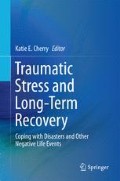Abstract
The common mantra for bereaved people these days is “Everyone grieves in their own way.” This is incontrovertibly true, yet it is not the whole truth. It is similarly true to say that grief is universal. This chapter provides a way of working with bereaved clients that honors both realities and focuses on work with complicated grief. We begin with an illustrative case study to highlight the features and clinical presentation of complicated grief, followed by a description of this syndrome, its associated features, and its risk factors. We describe complicated grief treatment (CGT), a proven efficacious approach that uses a framework in which the natural adaptation to loss is seen as derailed. The treatment has two main objectives: (1) to identify and resolve grief complications and (2) to facilitate the natural healing process. To achieve these goals, the therapist works to facilitate three main processes needed to reshape and integrate acute grief: acknowledging the finality of the death and its consequences, revising the mental representation of the person who has died, and restoring a sense of vitality and hope for the future. Core themes of the treatment include encouraging self-observation and reflection, rebuilding connections, focusing on both loss and restoration-related activities and fostering emotion regulation, including experiences of positive emotions.
Access this chapter
Tax calculation will be finalised at checkout
Purchases are for personal use only
References
Bartels, A., & Zeki, S. (2004). The neural correlates of maternal and romantic love. Neuroimage, 21(3), 1155–1166.
Bowlby, J. (1980). Loss: Sadness and depression (attachment and loss) (Vol. 3). New York: Basic Books.
Bowlby, J. (1988). A secure base: Clinical applications of attachment theory. London: Routledge.
Coan, J. A. (2008). Toward a neuroscience of attachment. In J. Cassidy & P. R. Shaver (Eds.), Handbook of attachment: Theory, research, and clinical applications (2nd edn., pp. 241–265). New York: Guilford.
Deci, E. L., & Ryan, R. M. (2000). The “what” and “why” of goal pursuits: Human needs and the self-determination of behavior. Psychological Inquiry, 11, 227–268.
Gilbert, D. T., Pinel, E. C., Wilson, T. D., Blumberg, S. J., & Wheatley, T. P. (1998). Immune neglect: A source of durability bias in affective forecasting. Journal of Personality and Social Psychology, 75(3), 617–638.
Gilbert, P. (2009). The compassionate mind: A new approach to life’s challenges. London: Constable & Robinson, Ltd.
Hodgekiss, A. (2013). You really CAN die of a broken heart: Surviving spouses have a 66 % higher risk of dying in the three months after their partner’s death. http://www.dailymail.co.uk/health/article-2507829/You-really-CAN-die-broken-heart-Surviving-spouses-66-higher-risk-dying-months-partners-death.html#ixzz2uuTqeKNI. Accessed 27 Jan 2015.
Kristjanson, L., Lobb, E., Aoun, S., & Monterosso, L. (2006). A systematic review of the literature on complicated grief. Department of health and ageing, Australian Government.
Meert, K. L., Shear, K., Newth, C. J., et al. (2011). Follow-up study of complicated grief among parents eighteen months after a child’s death in the pediatric intensive care unit. Journal of Palliative Medicine, 14, 207–214.
Miller W., & Rollnick, S. (2002). Motivational interviewing. New York: Guilford.
Mostofsky, E., Maclure, M., Sherwood, J. B., Tofler, G. H., Muller, J. E., & Mittleman, M. A. (2012). Risk of acute myocardial infarction after the death of a significant person in one’s life: The determinants of myocardial infarction onset study. Circulation, 125(3), 491–496.
Neff, K. D. (2011). Self-compassion: The proven power of being kind to yourself. New York: William.
Neimeyer, R. A., & Burke, L. A. (2013). Complicated grief and the end-of-life: Risk factors and treatment considerations. In J. L. Werth (Ed.), Counseling clients near the end-of-life (pp. 205–224). New York: Springer.
Prigerson, H. (2004). Complicated grief. Bereavement Care, 23(3), 38–40.
Prigerson, H. G., Maciejewski, P. K., Reynolds III, C. F., Bierhals, A. J., Newsom, J. T., Fasiczka, A., et al. (1995). Inventory of complicated grief: A scale to measure maladaptive symptoms of loss. Psychiatry Research, 59(1), 65–79.
Shear, K., Frank, E., Houck, P. R., & Reynolds, C. F. (2005). Treatment of complicated grief: a randomized controlled trial. JAMA, 293(21), 2601–2608.
Shear, K. M. (2010). Exploring the role of experiential avoidance from the perspective of attachment theory and the dual process model. Omega, 61(4), 357–369.
Shear, K. M. (2015). Complicated grief. New England Journal of Medicine, 372, 153–160.
Shear, M. K., Wang, Y., Skritskaya, N., Duan, N., Mauro, C., & Ghesquiere, A. (2014).Treatment of complicated grief in elderly persons: A randomized clinical trial. JAMA Psychiatry, 71(11), 1287–1295.
Stroebe, M. S., & Schut, H. (1999). The dual process model of coping with bereavement: Rationale and description. Death Studies, 23, 197–224.
Turret, N., & Shear, M. K. (2012). Grief monitoring diary. In R. A. Neimeyer (Ed.), Techniques of grief therapy: Creative practices for counseling the bereaved. New York: Routledge/Taylor & Francis Group.
Author information
Authors and Affiliations
Corresponding author
Editor information
Editors and Affiliations
Rights and permissions
Copyright information
© 2015 Springer International Publishing Switzerland
About this chapter
Cite this chapter
Shear, M., Delaney, S. (2015). On Bereavement and Grief: A Therapeutic Approach to Healing. In: Cherry, K. (eds) Traumatic Stress and Long-Term Recovery. Springer, Cham. https://doi.org/10.1007/978-3-319-18866-9_22
Download citation
DOI: https://doi.org/10.1007/978-3-319-18866-9_22
Published:
Publisher Name: Springer, Cham
Print ISBN: 978-3-319-18865-2
Online ISBN: 978-3-319-18866-9
eBook Packages: Behavioral ScienceBehavioral Science and Psychology (R0)

